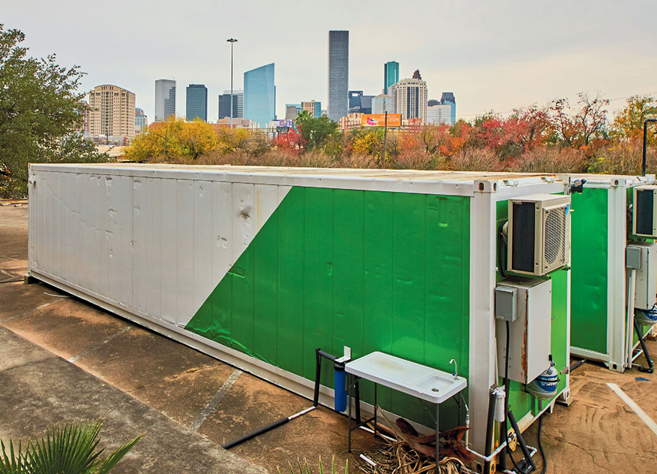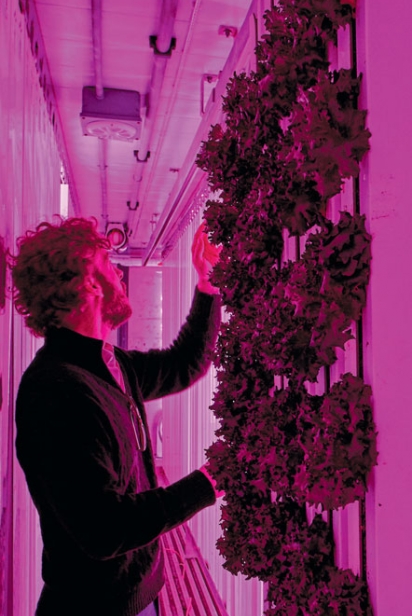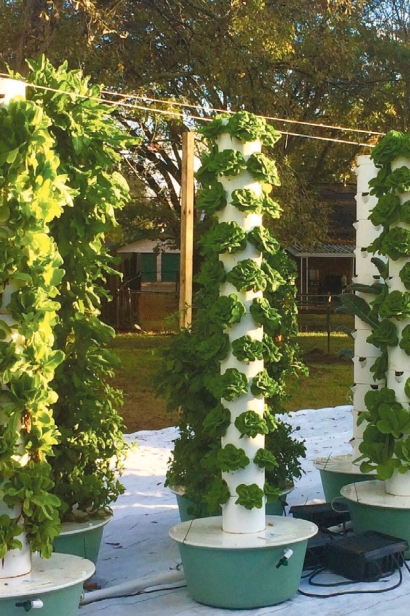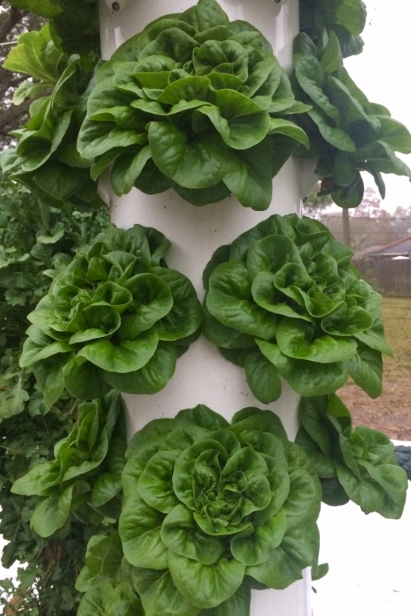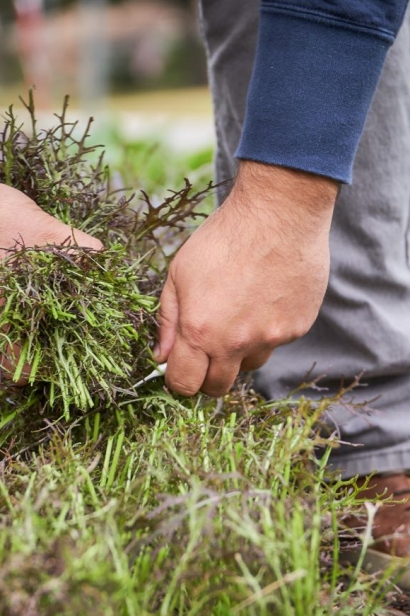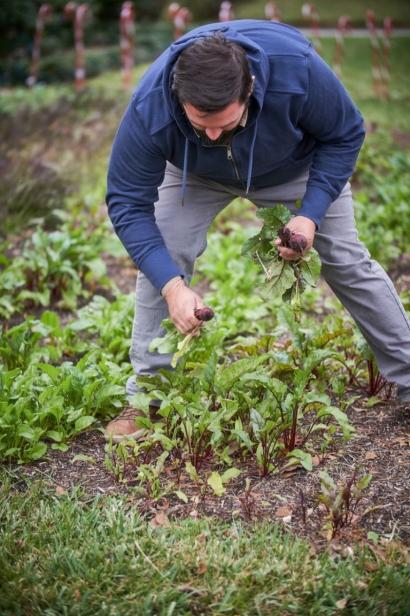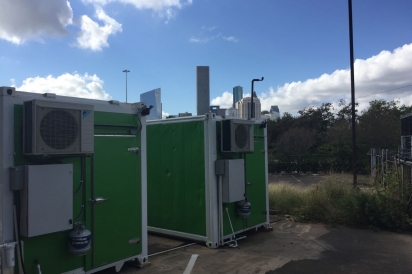Cropping Space
In an urban environment, where farmland acres don’t stretch far, space to grow food must be discovered in non-obvious places. Beyond community gardens and urban farms on vacant lots, space to grow food in the city is really anywhere anyone motivated to farm creates it.
Container farm in a parking lot
A stone’s throw from Minute Maid Park, two spring-green shipping containers squat in an otherwise empty parking lot. It’s a place you would least expect crisp leaf vegetables to grow. Yet behind their sturdy doors thrives a hydroponics farming system that produces a daily fresh harvest of greens.
Owned by Houston farming company Acre in a Box, these 40-foot shipping containers are the product of Freight Farms, a Boston-based company that transforms them into 320 square feet of growing space that can potentially produce two to four tons of fresh greens a year. The containers are outfitted with a fully assembled vertical hydroponic farming system, complete with innovative climate-control technology, a stainless-steel workbench with seedling growth area, lightweight crop columns, high-efficiency LED lights and a “farmhand”: a software platform to monitor climate, water, lights, etc.
The repurposed containers need only a 50- by 10-foot plot of leveled land with access to water and electricity. Established in 2010, Freight Farms—motto: “Grow food anywhere”— now has a network of 160 container farms throughout the U.S. as well as in the Netherlands and Dubai.
The container farm concept appealed to a team of urban professionals in Houston. “I work in oil and gas but I’ve always had a passion for green living, healthy living,” says Andrew Abendshein, one of six partners in Acre in a Box. Named for the equivalent of produce you’d get from an acre of land, Acre in a Box was born in May 2016 with the purchase of the first container, followed by a second one in November 2016. Ever since, a daily fresh harvest of a variety of greens—including mustard greens, basil, arugula, lettuces and kale—leaves the parking lot for transport to nearby clients.
“We are right downtown and all of our clients are within a five to 10 minute drive from here,” he says. Clients include local restaurants Relish, The Grove, Eloise Nichols, Tiny Boxwoods and Tinys No. 5. Central Market joins that list in early 2018.
Some greens, like the kale, are harvested by the leaf and continue to grow (“the kale you see has been in there for about a year now”). Lettuces are pulled out whole and taken to the restaurant roots and all. There is no soil involved: Seeds germinate in cubes of coconut fiber. To harvest, Abendshein simply takes the tower down, puts it flat on the table and pops out the lettuce heads.
While he comes in every morning at 6 to harvest, farming is largely done remotely, through an app on his phone. “I am able to monitor and see how the farm is doing: check the dosage of nutrients; check if the pH level is correct; make sure all the pumps are turning on; the lights are turning on, things like that,” says Abendshein.
The container’s closed-loop hydroponic system runs as much as it can on filtered recycled water, including the water from the A/C unit and humidifier.
“These [containers] could easily be run on solar power. The reason we don’t have that yet is because we don’t have the capital just yet,” says Abendshein, who imagines a future where these container farms operate on parking lots right outside supermarkets like H-E-B or Central Market, providing quite literally “harvest to shopping cart.”
Aeroponics in the backyard
“Americans have gotten away from eating seasonally, like our grandparents and great-grandparents did, and rely more on convenience. Our fruits and veggies sit on trucks that travel thousands of miles to get to our grocery stores [...] and are missing many phytonutrients that they would get in the last stage of ripening on the vine,” says Gary Maltz of Space City Farms, an aeroponics farm based in his own backyard in Pearland. In an aeroponics system— a type of hydroponics that differs in the distribution of water—plants receive water and nutrients misted onto the roots from the water basin below via a sump pump.
Maltz operates a Tower Garden system designed by Juice Plus+, a vertical system that can grow 20 vegetables, herbs, fruits (berries) and flowers in a space of less than three square feet. The systems can be operated indoors or outside. “In an aeroponic system like this, plants grow 50% faster than conventional methods, using 90% less water and less land,” says Maltz. “I loved that I could grow just about anything except root vegetables all in the same tower.”
Initially Maltz and his wife and partner, Tina, gave away their produce to neighbors, friends and family but soon felt inspired to take it to the next level and invest in more towers and go to market.
Why does someone start an aeroponics farm in their backyard to grow leaf vegetables for the local market? For Maltz it was health. “I have ADD and was diagnosed as a child. I’ve taken many prescription drugs associated with it, most of them were written in triplicate and they all had negative side effects; the highs, the lows; weight loss; mood swings; depression; the list goes on.”
Determined to change his medical routine, Maltz went to see a nutritionist and changed his diet (cutting out processed foods and sugar). Along the way he started a tower garden at home. Eating not only healthy food but healthy food he grew himself, Maltz was finally able to get off all his meds. Launching Space City Farms to him was a logical next step and as much about being able to provide locally grown produce as it was to help inspire healthy living.
Space City Farms currently operates 20 towers and is a vendor at Urban Harvest Eastside farmers market. Both partners have full-time jobs: Gary is a photographer and Tina manages buildings for the Houston Community College. “Fortunately, this system doesn’t require a lot of time; there’s no weeding, tilling or maintaining soil health,” says Maltz. “We germinate the seeds in rock wool, a volcanic spun material. We start the non-GMO seeds under grow lights for about two weeks and then transfer them to the grow slots in the towers.”
Typically, it takes about three weeks between germination and transfer to the towers, and another three weeks to fully grow—totaling six to seven weeks from seed to harvest.
Grow Food Not Lawns
In Houston’s Oak Forest, like so many residential areas characterized by sprawling lawns rather than pollinator-friendly shrubs and edible plants, one front yard stands out. It is a poster model for “Grow Food Not Lawns.” This yard has neatly planted rows of garden vegetables where there used to be lawn: beets, mizuna, kale, one straggler turnip from another harvest and a freshly raked and seeded bed that soon will sprout yellow beets—Tokyo Becana, to be precise. The owners opened up their yard to host Eureka Acres Urban Farms, owned and operated by Joseph Stark, who now has ¼ acre under cultivation. In return for the use of their land the owners get a CSA-style share of the vegetables each week that he harvests from their yard.
Born and raised in Houston, Stark, 37, is a SPIN farmer, short for Small Plots INtensive farming. SPIN farmers utilize garden-size plots such as private yards to produce a farm-size harvest based on the principle that “anybody can farm anywhere.”
“SPIN farming was developed in Canada a decade or so ago in response to the incredibly high cost of entry to agriculture,” says Stark. “In SPIN, the farmer networks through their local community and finds property owners who share the same values.”
The self-taught farmer (“I grew some radishes and beets in my mother’s yard when I was about 8 but that’s about it”) learned via YouTube from market gardeners like Canadian Curtis Stone and French-Canadian Jean-Martin Fortier.
“The whole concept of a diversified, real-food-type system ... once I got into that it made a lot of sense,” says Stark. He researched everything he could find on sustainable farming, quite literally from seed to soil health. “I came close to qualifying for analysis paralysis,” laughs Stark about the moment he realized that it was time to move on from merely studying and put what he had learned into practice.
Eureka Acres Urban Farms launched in May 2017 in Stark’s own backyard and has since acquired the use of another four neighborhood host gardens. “I used various social media channels to place ads and met with each person who reached out. Once the preliminary work is done, I create the garden space, amend the soil, seed and transplant the crops and care for them,” says Stark. One of his criteria is that each plot has to be within 10 minutes of his house. As long as his total acreage stays below half an acre, he will do it all by himself, from seeding to harvest and market vending.
Amending the soil was the first and biggest step. Lawn plots contain soil that is compacted and pretty much depleted of nutrients. For his first lots alone, Stark calculated that he moved about 32,000 pounds of compost by wheelbarrow in a four-week period.
By June 2017 the first beds were sprouting and by July he started as a vendor at several markets, including Westchase on Thursday afternoons and East End on Sunday mornings, and selling wholesale to Central City Co-Op.
In the established beds Stark grows a variety of greens, root vegetables and, in season, he grows tomatoes. Stark is planning to grow flowers as well: “Flowers attract pollinators and ladybugs.” Ladybugs especially eat pests like aphids that damage crops. “Plus, it’s gonna make the yard look nicer for the owners.”
A Swedish Model
In a brief conversation about sustainable urban food production, Prof. Richard Johnson, who specializes in environmental studies and directs the Administrative Center for Sustainability and Energy Management at Rice University, points out the potential for high-volume production from small (hydroponics) growing systems, and the role they can play in urban food production. As an example, Johnson mentions an urban farming facility called Stadsjord that he visited in Göteborg in southern Sweden. Stadsjord runs a tight aquaponics system on the ground floor of a residential building. It occupies not even 540 square feet yet supplies the 100 residents who live above it with fish and greens. When I email Stadsjord’s CEO Niklas Wennberg, he responds: “Next year we build our second system just outside Göteborg and in 2020 we build a system in central Malmö in the far south of Sweden.” He highlights that “all this” is financially supported by the Swedish government and that in future residential development planning, the production of fish and vegetables from small-scale aquaponics systems will be an integrated part.
“If we’re going to feed a planet of 10 billion by 2050 with roughly 7 billion of those people living in urban areas, then we’re going to need to figure out how to do this [urban farming systems] well,” Johnson emphasizes.
According to Johnson, “The path ahead takes us well past the urban community garden model—which in many cities is basically the extent of urban agriculture—to a world of innovation, new technology, new business models and job creation.”


